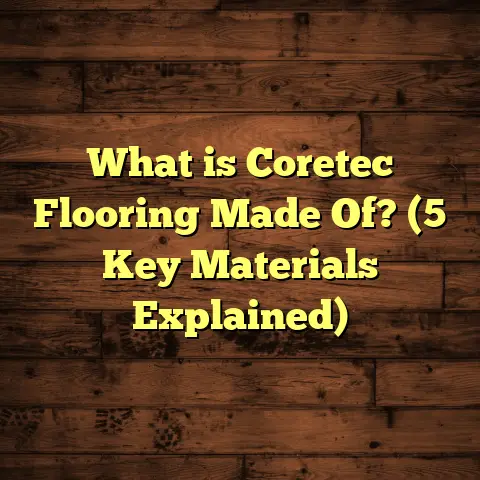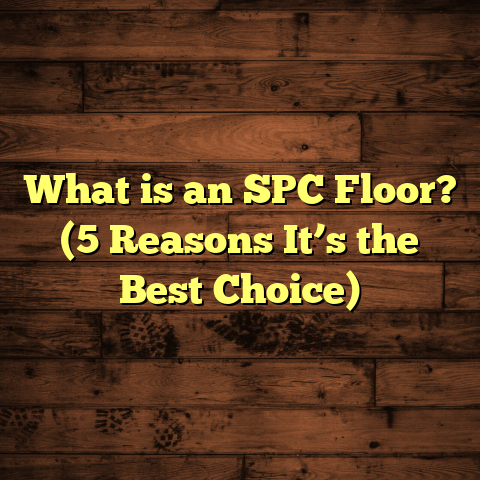What Is Floor Decking? (5 Types You Need to Know)
The Versatility of Floor Decking
I’ve always found floor decking to be one of the most versatile components in construction and design. It’s not just a surface to walk on but the backbone that supports everything above it. No matter if you’re working on a cozy cabin in the woods, a sprawling urban rooftop deck, or a commercial office building, floor decking adapts to many environments and needs.
When I first started in flooring projects over 15 years ago, I used to see decking simply as the platform for floors. But over time, I realized it’s so much more—acting as a critical factor that influences durability, safety, aesthetics, and even energy efficiency. There’s something exciting about knowing that the choices you make in decking materials can affect how a space feels and performs for decades.
For example, I once helped a client whose home had major issues with sagging floors. After inspecting the subfloor and decking system, it was clear that poor-quality plywood and inadequate joist spacing were to blame. Fixing that involved redesigning the deck structure entirely. That project taught me how crucial the right decking is not just for new builds but also for renovations.
What Is Floor Decking?
Floor decking refers to the flat surface or structural component that supports the flooring material you walk on. It acts as the foundation for all types of floors—hardwood, tile, carpet, laminate, or outdoor decking boards.
In residential construction, floor decking usually sits on top of joists or beams and transfers loads safely to the building’s framework. In commercial and industrial buildings, decking can be more complex, involving metal sheets topped with concrete slabs.
The Anatomy of Floor Decking
Floor decking can vary widely depending on the project type:
- Wood decking: Solid wood or engineered wood boards nailed or screwed to joists.
- Metal decking: Corrugated steel or aluminum sheets fastened to structural beams.
- Concrete decking: Cast-in-place concrete slabs poured over metal or wood forms.
- Composite decking: Synthetic boards made from recycled plastics and wood fibers.
- Plywood decking: Sheets of plywood subflooring installed over joists indoors.
Why Is Floor Decking So Important?
The decking system is responsible for:
- Load distribution: Carrying weight from people, furniture, equipment.
- Structural integrity: Keeping floors level and preventing sagging or collapse.
- Moisture control: Proper spacing and materials help avoid water damage.
- Noise reduction: Stiff decking reduces squeaks and creaks.
- Thermal performance: Some decking improves insulation and energy efficiency.
Ignoring the role of decking can lead to costly repairs down the road. For instance, I once encountered a condo where improper plywood subflooring caused warping under tile floors—leading to cracked tiles and grout. Upgrading the decking fixed the root issue.
1. Wood Decking: The Classic Choice
Wood has been a go-to decking material for centuries. Its natural warmth and strength make it perfect for residential decks, porches, and even indoor flooring support.
Types of Wood Used for Decking
In my many projects, I’ve worked with:
- Pressure-treated pine: Affordable and resistant to rot due to chemical treatment. Usually 5/4 inch thick (approximately 1.25 inches).
- Cedar and redwood: Naturally decay-resistant softwoods that look great but come at a higher price.
- Hardwoods like ipe or mahogany: Dense tropical woods offering extreme durability but require special tools for installation.
Common Dimensions
Typically, wood deck boards come in lengths from 8 to 16 feet and widths of 5.5 inches (standard “deck board” size). Thickness varies around 1 to 1.5 inches.
Joists supporting these boards are spaced 16 inches on center for residential decks, sometimes 12 inches for heavier loads.
Cost Breakdown
Wood decking costs vary by species and region. For example:
| Material | Cost per sq.ft (installed) | Longevity (years) | Maintenance |
|---|---|---|---|
| Pressure-treated pine | $15 – $25 | 15 – 20 | Annual sealing/staining |
| Cedar/Redwood | $25 – $45 | 20 – 30 | Every 2 years sealing |
| Hardwood (Ipe) | $30 – $60 | 30+ | Minimal if properly finished |
In one project in Atlanta, using cedar instead of pine added about $1,500 to a 500-square-foot deck but saved clients tons of future maintenance hassle.
Installation Tips from Experience
When installing wood decking:
- Always leave a 1/8-inch gap between boards for water drainage and wood expansion.
- Use stainless steel or coated screws to prevent rust staining.
- Seal or stain wood within two weeks after installation to lock in moisture resistance.
I’ve found skipping these steps leads to faster decay; an outdoor deck I built once began showing rot within three years because these were overlooked.
Wood Decking Pros and Cons
Pros:
- Beautiful natural grain and color.
- Easy to cut and shape on-site.
- Relatively affordable initial cost.
Cons:
- Requires ongoing maintenance.
- Vulnerable to insects without chemical treatment.
- Can warp or split if exposed to moisture long-term.
2. Metal Decking: Strength Meets Speed
Metal decking is common in commercial construction but less used in residential settings unless you’re going for an industrial look or need extreme strength.
What is Metal Decking?
Typically made of galvanized steel sheets with ribbed profiles that add stiffness. These sheets are fastened across steel beams and often serve as a base for concrete slabs.
Dimensions and Installation
Common panels are 3 feet wide with rib heights around 1.5 inches. Lengths vary but can be custom ordered up to 40 feet or longer.
Installation is fast—panels can be lifted into place by cranes on larger projects and secured with screws every 6 inches along joists.
Real Project Example
On a mid-rise office building I worked on in Chicago’s downtown area:
- Installed over 15,000 square feet of metal decking in under three weeks.
- Cost of metal decking was around $5 per square foot.
- Concrete topping slab poured over it was approximately $12 per square foot.
- Total deck system installation time was half what traditional wood framing would have required.
Why Choose Metal Decking?
- High strength-to-weight ratio.
- Fire-resistant—steel won’t burn.
- Durable against pests and weather.
- Good for long spans without intermediate support.
The downside? It’s noisy underfoot unless covered with concrete or other layers and requires skilled labor and equipment.
3. Concrete Decking: Durable & Robust
Concrete is a heavyweight champion when it comes to longevity and strength.
How Concrete Decking Works
Concrete slabs can act as standalone decks (like balconies) or be poured over metal decking acting as formwork.
In multi-story buildings, composite decks combine metal decking with concrete slabs reinforced with steel bars (rebar).
Thickness & Specifications
Typical concrete slab thickness ranges from:
- Residential patios/balconies: 4 inches
- Commercial floors/garages: 6 to 8 inches
Concrete strength is measured in PSI (pounds per square inch). Most floor slabs use mixes with 3,000 to 4,000 PSI compressive strength.
Cost Factors & Timing
Concrete costs depend heavily on mix design, labor rates, finishing methods:
| Aspect | Cost Per Sq.Ft (Approximate) |
|---|---|
| Basic slab (pour only) | $6 – $9 |
| Reinforced slab | $9 – $12 |
| Polished concrete | $15 – $25 |
Curing time is critical—a slab typically reaches usable strength after 24-48 hours but fully cures over about 28 days.
Personal Story
I recall a warehouse renovation in Dallas where we replaced old wooden subfloors with concrete slabs over metal decking. The change cut maintenance dramatically. The client reported zero issues after five years despite heavy forklift traffic.
Pros and Cons
Pros:
- Extremely durable and long-lasting.
- Fireproof and pest-resistant.
- Can be finished with various textures/colors.
Cons:
- Heavy—needs strong support structure.
- Longer installation time due to curing.
- Higher upfront costs compared to wood.
4. Composite Decking: Low Maintenance Winner
Composite decking combines wood fibers with plastics recycled from bottles or bags—a great eco-friendly option that reduces upkeep headaches.
Composition & Sizes
Boards typically measure around:
- Thickness: 1.25 inches
- Width: 5.5 inches
- Lengths: Up to 20 feet
They come pre-finished with textured surfaces replicating wood grain.
Installation Notes
Composite boards install similarly to wood but require hidden fasteners or screws designed specifically for composite material to avoid splitting.
Spacing recommendations are important due to different expansion rates compared to wood; usually around 1/8 inch gap between boards.
Costs & Longevity
Composite decks cost about $25-$45 per square foot installed. Although pricier than traditional wood decks upfront, they require no staining or sealing—saving time and money long-term.
I installed composite decking on a Seattle waterfront home prone to heavy rain. After six years, no warping or fading occurred despite harsh weather conditions.
5. Plywood Decking: The Unsung Hero Indoors
Plywood might not be glamorous but it’s foundational inside many buildings as subflooring beneath finish floors like carpet, tile, hardwood, or vinyl.
Grades & Thicknesses
Common plywood thicknesses used for subfloors are:
- 3/8 inch (used mostly as underlayment)
- 1/2 inch
- 5/8 inch
- 3/4 inch (most popular for subfloors)
Higher grades have fewer knots and defects—important beneath tile floors which are unforgiving of movement.
Installation Best Practices
I always recommend tongue-and-groove plywood because it locks sheets together tightly reducing squeaks and movement.
Sheets are fastened every 6 inches along joists using ring-shank nails or screws designed for subfloor use.
Cost Considerations
Plywood prices fluctuate based on grade and location but average $20-$35 per sheet (4×8 feet). Labor depends on accessibility but replacement usually takes 1-2 days for an average room.
Comparing Floor Decking Types Side by Side
Here’s a quick comparison table I often share with clients when deciding among options:
| Type | Cost/Sq.Ft Installed | Lifespan (Years) | Maintenance | Strength | Ideal Use |
|---|---|---|---|---|---|
| Wood | $15-$45 | 15-30 | Annual sealing | Moderate | Residential decks/outdoor patios |
| Metal | $5-$7 (material) | 50+ | Minimal | Very High | Commercial floors & roofs |
| Concrete | $6-$12 | 50+ | Low | Very High | Commercial/residential slabs |
| Composite | $25-$45 | 25+ | Minimal | High | Outdoor decks |
| Plywood | $0.60-$1 per sq.ft sheet* | 20+ | Minimal | Moderate | Indoor subflooring |
*Cost per square foot calculated from typical sheet prices divided by area.
Maintenance Tips from My Experience
I always tell clients maintenance is key no matter what decking they choose:
- Wood decks: Clean annually with deck cleaner; reseal every year or two depending on exposure.
- Metal decks: Inspect fasteners yearly; keep drainage paths clear.
- Concrete decks: Seal cracks immediately; reseal surface every 3–5 years if polished.
- Composite decks: Wash annually with soap/water; avoid harsh chemicals that degrade plastic fibers.
- Plywood subfloors: Keep dry; fix leaks promptly to prevent rot.
Troubleshooting Common Issues I’ve Encountered
No material is perfect. Here are some problems I’ve seen and how I fixed them:
- Warped wood boards: Caused by trapped moisture; replaced damaged boards and improved ventilation beneath deck.
- Corroded metal decking: Occurred where flashing failed; added protective coatings and proper water drainage systems.
- Cracked concrete slabs: Usually due to poor curing; applied epoxy injections and overlays after fixing causes.
- Composite board fading: Happened when low-quality products used; switched brands with UV inhibitors.
- Plywood squeaks: Fixed by adding screws along edges and applying construction adhesive between sheets during installation.
Case Study #1: Rooftop Deck in Chicago
We built a rooftop deck on a commercial building using composite decking over a metal deck base system. Key details:
- Size: 2,000 sq.ft
- Materials cost: $35 per sq.ft composite + $6 per sq.ft metal deck
- Installation time: Four weeks total
- Challenges: Weather delays; required precise spacing for drainage
- Outcome: Client thrilled with low maintenance and durability despite city weather extremes
Case Study #2: Coastal Home in Florida
A family wanted a natural wood deck but worried about saltwater exposure:
- Used pressure-treated pine with marine-grade sealant
- Board spacing increased slightly for better airflow
- Added stainless steel fasteners to prevent rust staining
- Cost: Approximately $22 per sq.ft installed
- After five years: Minor maintenance needed; no rot detected despite hurricane exposure
My Personal Tips for Choosing Floor Decking
If you’re asking yourself which option fits your project best:
- Think about location—indoor vs outdoor changes everything.
- Consider foot traffic—heavy use needs stronger materials.
- Factor climate—wet areas demand rot-resistant choices.
- Budget realistically—not just upfront costs but long-term care.
- Timeframe matters—some materials install faster than others.
For example, if you want a quick DIY weekend project on your backyard deck, composite might save time since it doesn’t require staining later. On the other hand, if you want something classic and budget-friendly for an indoor floor foundation, plywood is hard to beat.
Final Thoughts on Floor Decking Types You Need To Know
Choosing the right floor decking is one of those decisions that quietly shapes your entire space’s comfort and longevity. I hope sharing my hands-on experience with wood, metal, concrete, composite, and plywood decking gives you solid footing (pun intended!) to plan your next project confidently.
If you have questions about installation specifics or want help budgeting your flooring project accurately—I use tools like FloorTally regularly—you can always reach out!
Now I’m curious—what kind of flooring project do you have in mind? Maybe I can share some tailored tips based on my past jobs!





